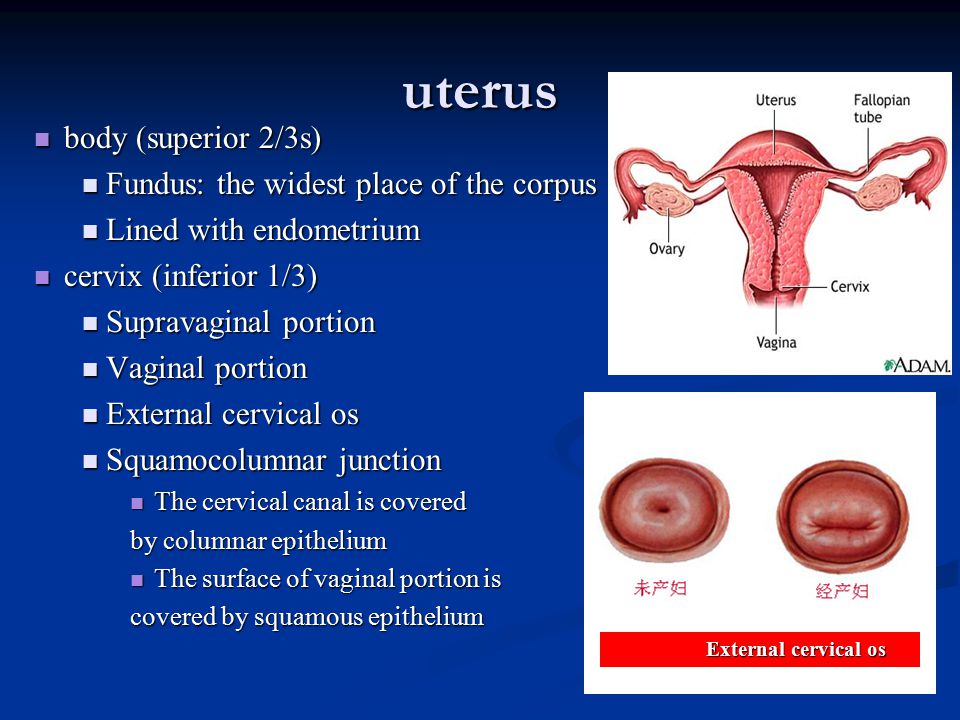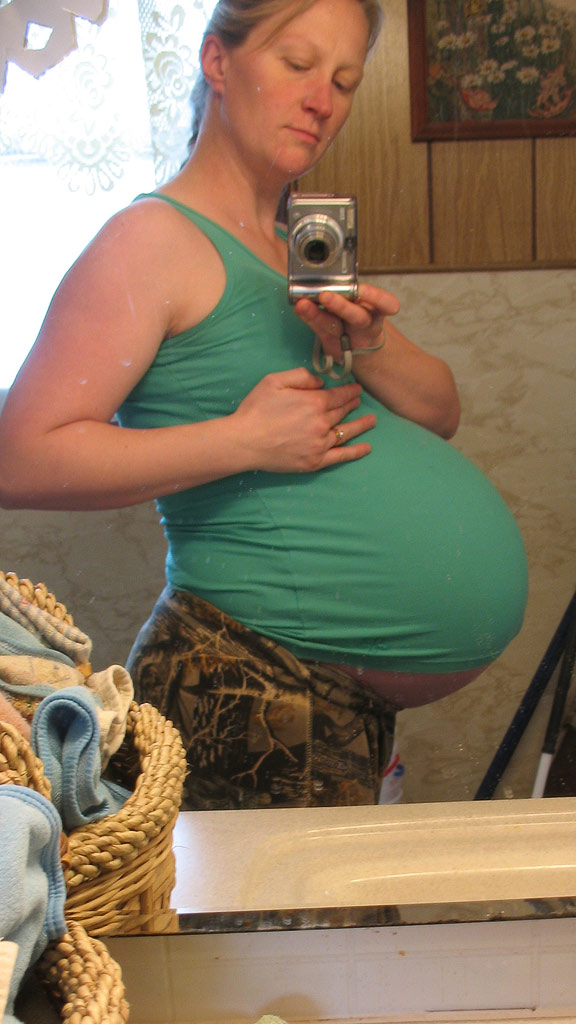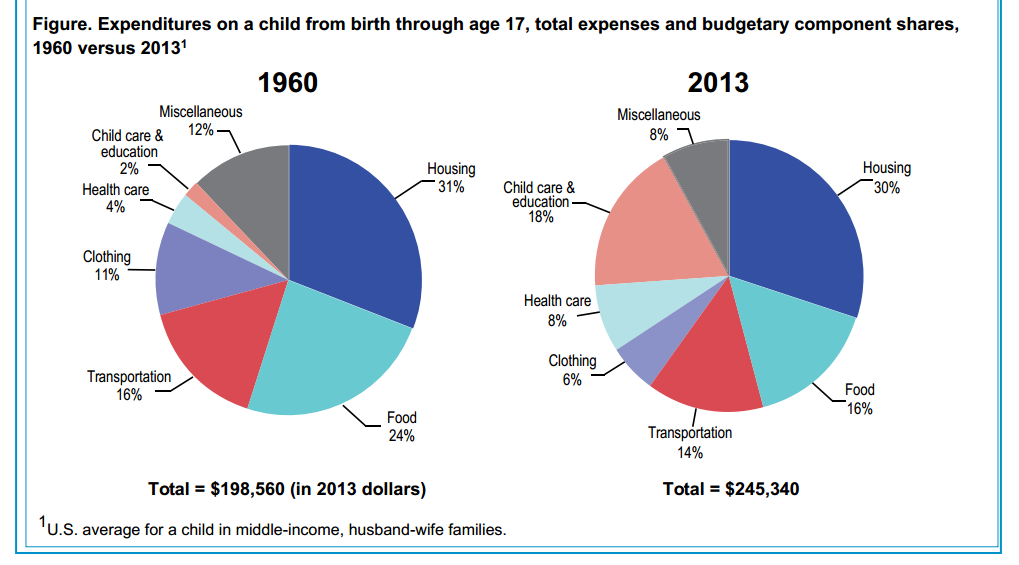How to calculate pregnancy with irregular periods
How are Due Dates Calculated
Keywords
Dani Kurtz
If you were having regular periods before pregnancy, your doctor will calculate your due date based off of your last menstrual period. This goes back to the fact that in order to get pregnant, your body ovulated—or released an egg—roughly in the middle of your cycle and it was fertilized by sperm. That was the moment of conception.
By the time most women miss a period and find out they’re pregnant, the baby has been growing for 2 weeks, but the mother is actually 4 weeks along because the gestational period starts with the first day of your last period.
To clarify, the gestational period of 40 weeks actually starts with the first day of your last period, which adds two weeks of time to the gestational period when your baby didn’t even exist yet…clear as mud, right?
Is an ultrasound a more accurate way of finding out my due date?
If you are having irregular cycles before getting pregnant, an ultrasound is usually done to find out how far along you are. An ultrasound is actually the most accurate way to date a pregnancy because all fetuses grow at a consistent rate during the first trimester and early second.
In other words, if your baby measures 9 weeks 2 days when you have your ultrasound, that’s how far along you are, no matter when your last period was.
Some women with regular cycles are confused about why their ultrasound due date doesn’t match up with their last menstrual period due date.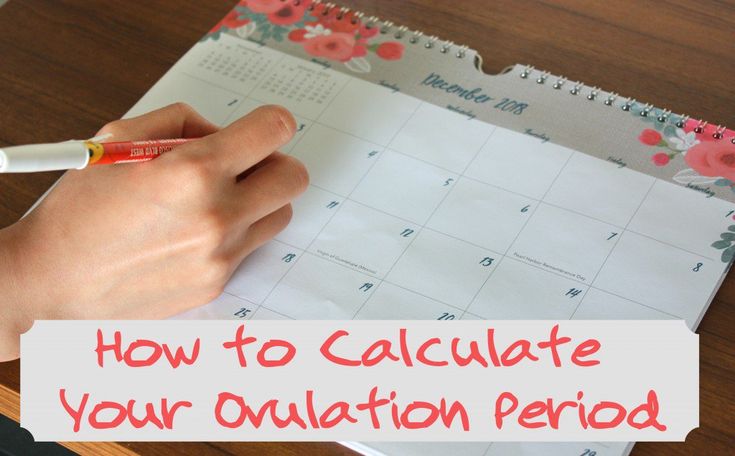 Ovulation isn’t a perfect science and can happen earlier or later than the norm, which might shift your due date slightly.
Ovulation isn’t a perfect science and can happen earlier or later than the norm, which might shift your due date slightly.
That’s okay…a few days or even a week of discrepancy won’t change your dates. Your doctor will go with the due date obtained from your ultrasound.
What happens if my baby is measuring big or small later on? Does my due date need to change or will I deliver early?
You’ll notice at every prenatal appointment after 20 weeks, your doctor will measure your belly. That measurement should match your gestational age in centimeters. If you are measuring smaller or larger than what you should be, then the doctor might order an ultrasound. This will tell them if the discrepancy is due to the actual size of the baby, the amount of fluid surrounding the baby, or maybe just the way you’re carrying the baby.
If the baby is actually smaller or larger than what they should be, underlying issues need to be considered that might be causing the discrepancy in growth.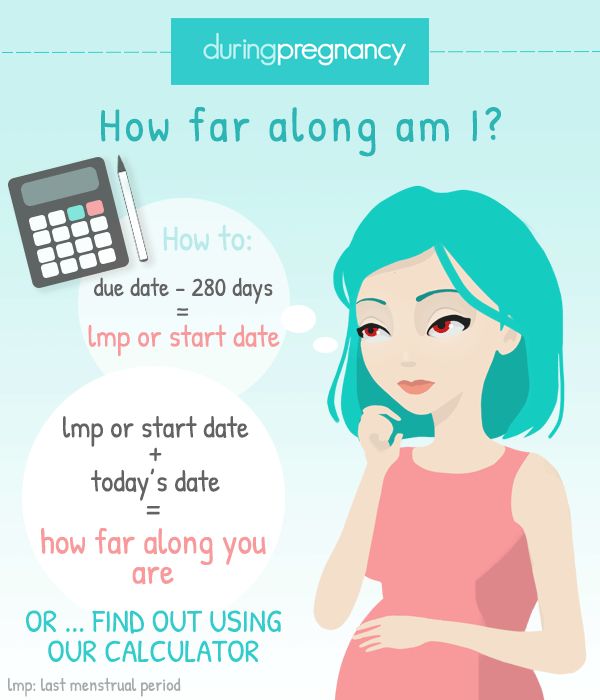 For example, mothers with uncontrolled diabetes (Type 1, Type 2, or Gestational) cook very large babies. When a baby is small, it might be due to a placenta that’s not working like it should.
For example, mothers with uncontrolled diabetes (Type 1, Type 2, or Gestational) cook very large babies. When a baby is small, it might be due to a placenta that’s not working like it should.
These discrepancies might affect delivery, but they might not. For example, if your baby is consistently measuring small and falling below where they should be, your doctor might decide you need to be delivered because your baby would be better out than in.
If your baby is extra big and you’re measuring 40 weeks at 37 weeks, your body might think it’s done and go into labor early….or you might go to your due date and things will go as planned. If you have questions about your due date, talk with your doctor who can give you the best information.
Intermountain Moms
Last Updated: 10/27/2017
-
Intermountain Moms
-
Intermountain Moms
-
Intermountain Moms
-
Intermountain Moms
-
Intermountain Moms
-
Intermountain Moms
-
Intermountain Moms
-
Intermountain Moms
Copyright ©2022, Intermountain Healthcare, All rights reserved.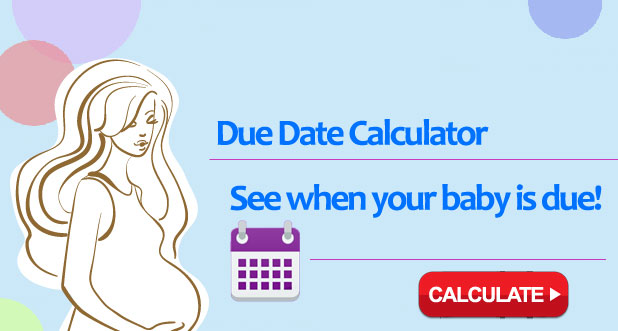
How to Calculate Your Due Date
Pregnancy lasts an average of 280 days (40 weeks) from the first day of your last menstrual period (LMP). The first day of your LMP is considered day one of pregnancy, even though you probably didn’t conceive until about two weeks later (fetal development lags two weeks behind your pregnancy dates).
Read our report on the 13 best pregnancy iPhone and Android apps of the year here.
Calculating your due date isn’t an exact science. Very few women actually deliver on their due date, so, while it’s important to have an idea of when your baby will be born, try not to get too attached to the exact date.
If you have regular 28-day menstrual cycles, there are two ways to calculate your due date.
Naegele’s rule
Naegele’s rule involves a simple calculation: Add seven days to the first day of your LMP and then subtract three months.
For example, if your LMP was November 1, 2017:
- Add seven days (November 8, 2017).
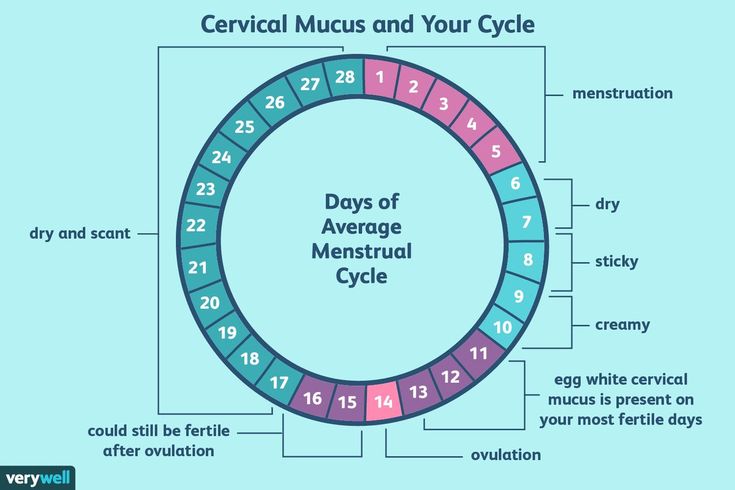
- Subtract three months (August 8, 2017).
- Change the year, if necessary (to the year 2018, in this case).
In this example, the due date would be August 8, 2018.
Pregnancy wheel
The other way to calculate your due date is to use a pregnancy wheel. This is the method that most doctors use. It’s very easy to estimate your due date if you have access to a pregnancy wheel.
The first step is locating the date of your LMP on the wheel. When you line up that date with the indicator, the wheel displays your due date.
Remember that the due date is only an estimate of when you will deliver your baby. The chances of actually having your baby on that exact date are very slim.
This is more common than you’d think. Luckily, there are ways to figure out your due date when you can’t remember the first day of your LMP:
- If you know you had your LMP during a particular week, your doctor can estimate your due date accordingly.
- If you have no idea when your last period was, your doctor may order an ultrasound to determine your due date.
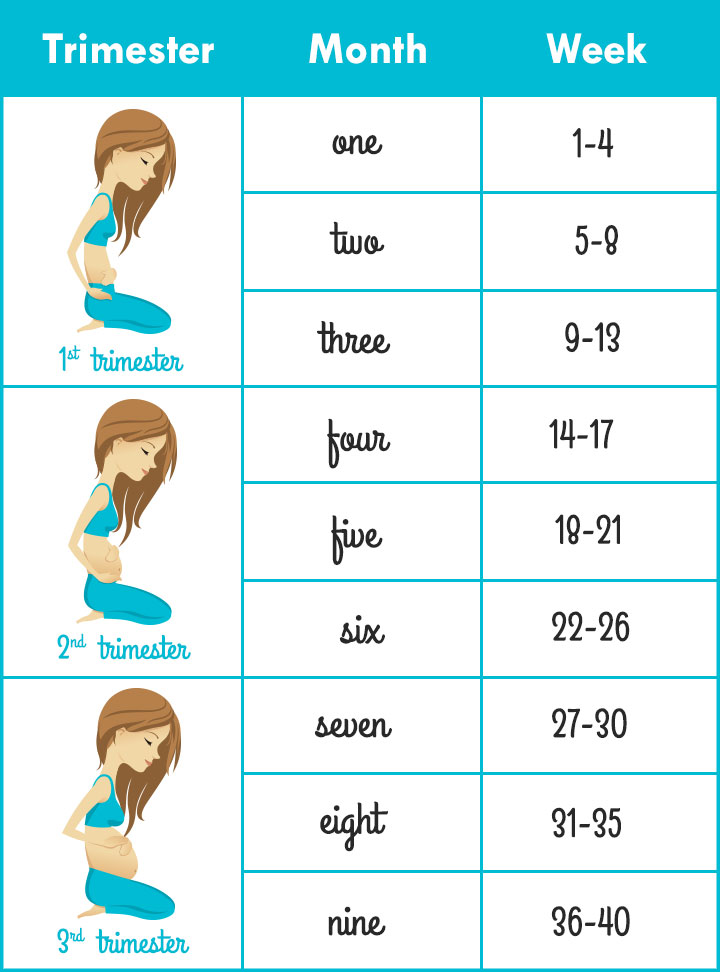
Some women have cycles that are consistently longer than the average 28-day cycle. In these cases, a pregnancy wheel can still be used, but some simple calculations are necessary.
The second half of a woman’s menstrual cycle always lasts for 14 days. This is the time from ovulation to the next menstrual period. If your cycle is 35 days long, for example, then you probably ovulated on day 21.
Once you have a general idea of when you ovulated, you can use an adjusted LMP to find your due date with a pregnancy wheel.
For example, if your menstrual cycle is usually 35 days long and the first day of your LMP was November 1:
- Add 21 days (November 22).
- Subtract 14 days to find your adjusted LMP date (November 8).
After you calculate your adjusted LMP date, simply mark it on the pregnancy wheel and then look at the date where the line crosses. That is your estimated due date.
Some pregnancy wheels may allow you to enter the date of conception — which occurs within 72 hours of ovulation — instead of the date of your LMP.
Your doctor may change your due date if your fetus is significantly smaller or larger than the average fetus at your particular stage of pregnancy.
Generally, your doctor orders an ultrasound to determine the gestational age of your baby when there’s a history of irregular periods, when the date of your LMP is uncertain, or when conception occurred despite oral contraceptive use.
An ultrasound allows your doctor to measure the crown-rump length (CRL) — the length of the fetus from one end to the other.
During the first trimester, this measurement provides the most accurate estimation for the age of the baby. Your doctor may change your due date based on the ultrasound measurement.
This is most likely to occur in the first trimester, especially if the date estimated by the ultrasound differs by more than one week from the date estimated by your doctor based on your LMP.
In the second trimester, an ultrasound is less accurate and your doctor probably won’t adjust your date unless the estimates vary by more than two weeks.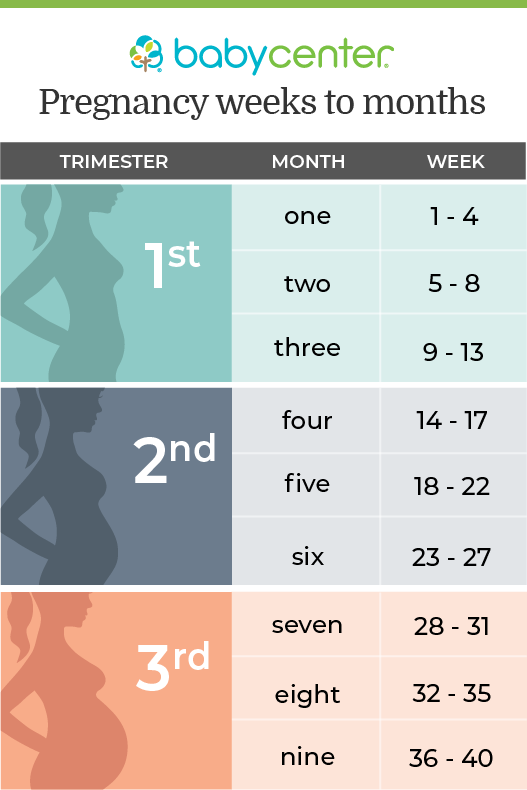
The third trimester is the least accurate time to date a pregnancy. Estimates based on an ultrasound can be off by as much as three weeks, so doctors rarely adjust dates during the third trimester.
However, it’s not uncommon for a doctor to perform an ultrasound in the third trimester if they’re thinking about changing your date.
A repeat ultrasound provides valuable information about the growth of the fetus and may reassure you and your doctor that the change in due date is reasonable.
Did you know?Ultrasound measurements for estimating the age of a fetus are more accurate during the early stages of pregnancy. In the first few weeks, fetuses tend to develop at the same rate. However, as pregnancy progresses, the rates of fetal growth begin to vary from pregnancy to pregnancy.
This is why ultrasound measurements can’t be used to accurately predict the age of the baby in the later stages of pregnancy.
Ultrasounds are not a necessary part of prenatal care.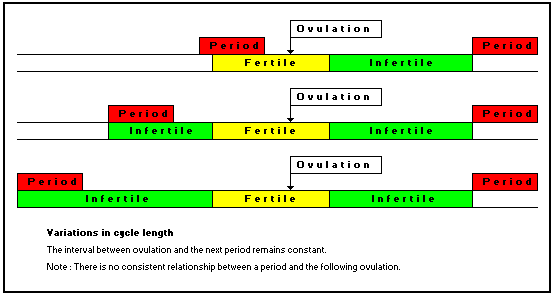 Avoid numerous scansTrusted Source and have ultrasounds for medical reasons only.
Avoid numerous scansTrusted Source and have ultrasounds for medical reasons only.
When a doctor performs an ultrasound, they write a report on the findings and include two estimated due dates. The first date is calculated using the date of the LMP. The second date is based on the ultrasound measurements. These dates are rarely the same.
When your doctor evaluates the ultrasound results, they’ll determine whether or not these dates are in agreement. Your doctor probably won’t change your due date unless its significantly different from your ultrasound date.
If you have more ultrasounds, each ultrasound report will contain a new due date based on the most recent measurements. An expected due date shouldn’t be changed based on measurements from a second- or third-trimester ultrasound.
Due date estimations are more accurate earlier in pregnancy. Later ultrasounds are helpful in determining whether the fetus is growing well but not for determining the age of the fetus.
Learn more about how your body changes during your pregnancy.
- ACOG reinvents the pregnancy wheel: Launches new due date app. (2016). https://www.acog.org/About-ACOG/News-Room/News-Releases/2016/ACOG-Reinvents-the-Pregnancy-Wheel
- Avoid fetal “keepsake” images, heartbeat monitors. (2014). https://www.fda.gov/ForConsumers/ConsumerUpdates/ucm095508.htmTrusted Source
- Calculating a due date. (n.d.). http://www.hopkinsmedicine.org/healthlibrary/conditions/pregnancy_and_childbirth/calculating_a_due_date_85,P01209/
- Calculating your estimated due date. (2014). https://my.clevelandclinic.org/health/diseases_conditions/hic_Am_I_Pregnant/hic_Calculating_Your_Estimated_Due_Date
- Due date calculator. (n.d.). http://www.marchofdimes.org/pregnancy/calculating-your-due-date.aspx
- Pregnancy due date and gestational age calculator. (n.d.). http://www.perinatology.com/calculators/Due-Date.htm
How to determine the duration of pregnancy | Center for Fetal Medicine at Chistye Prudy
- Methods for determining the duration of pregnancy
- Embryonic term
- Obstetric term
- By last menstrual period
- By ovulation date or conception date
- According to the size of the uterus
- Ultrasound
- According to the level of hCG in the blood
- By the first movement of the fetus
Here is a pregnancy test showed the coveted two strips, the expectant mother is in a hurry to register at the antenatal clinic. The first thing that an obstetrician-gynecologist determines when registering is the gestational age. This indicator is extremely important in order to understand whether the pregnancy is proceeding correctly and the baby is developing, when it is necessary to take tests and undergo additional examinations, when to go on maternity leave and wait for the baby to be born.
The first thing that an obstetrician-gynecologist determines when registering is the gestational age. This indicator is extremely important in order to understand whether the pregnancy is proceeding correctly and the baby is developing, when it is necessary to take tests and undergo additional examinations, when to go on maternity leave and wait for the baby to be born.
It is also very important to know the exact gestational age for screening for the presence of genetic abnormalities in the fetus (ultrasound and blood tests), since these examinations are carried out strictly at certain times of pregnancy.
Turning to an obstetrician-gynecologist, many expectant mothers begin to worry about the difference in terms of pregnancy - what the doctor calculated and the woman herself. In order not to worry in vain, you need to know that there are 2 stages of pregnancy - obstetric and embryonic.
Fetal term
This is the true gestational age from conception, it usually lags behind the obstetric term by about 2 weeks.
Obstetric term
Doctors determine it from the first day of the last menstruation before pregnancy. It should be remembered that all doctors use only the obstetric term, all test results, the size of the fetus, the timing of examinations, maternity leave and the term of delivery are calculated taking into account only the obstetric term of pregnancy.
There are several ways to determine the gestational age.
Determination of the gestational age by the date of the last menstrual period
This is the most common way to calculate the gestational age. However, it can only be used if a woman's menstruation comes regularly at the same interval.
It is not always possible to accurately calculate the duration of pregnancy, guided only by the date of the last menstruation. This happens in cases where a woman has irregular menstruation or in those patients who have a regular but long menstrual cycle. For example, if a woman has a typical cycle length of 35 days (and not 26 - 28, like most women), then most likely she will only be able to conceive on about the 21st day of the cycle (and not on the 14th, as on a 28 day cycle). Accordingly, the period calculated by menstruation will exceed the “real” obstetric gestational age by a week.
Accordingly, the period calculated by menstruation will exceed the “real” obstetric gestational age by a week.
According to the date of ovulation or the date of conception
If the date of conception is known, two weeks must be added to this date - we will get the obstetric gestational age. However, it must be remembered that even if a woman knows exactly the date of ovulation or the date of sexual intercourse, after which pregnancy occurred, this does not mean that she absolutely knows the date of conception.
A spermatozoon that has entered the female body is capable of fertilization within 4-5 days, sometimes even within a week, and a mature egg retains the ability to conceive for 2 days after ovulation. Therefore, even knowing exactly the date of sexual intercourse or ovulation, it is impossible to say with accuracy that fertilization occurred on that day. It could have happened later. Therefore, the period calculated by ovulation or the date of conception cannot be considered completely accurate.
Doctors calculate the gestational age in a slightly different way in cases where pregnancy has occurred as a result of IVF. In this case, the fertilization of the egg by the spermatozoon is carried out "in vitro" by the embryologist. Embryos develop in the laboratory for 3-5 days, after which they are transferred to the uterus.
Doctors calculate the true duration of pregnancy after IVF from the date of ovarian puncture, that is, the stage of the procedure, when the follicular fluid and the follicles contained in it are taken with a special needle for subsequent fertilization “in vitro”, and to determine the “usual” obstetric period , add 2 weeks in the date of ovarian puncture.
If the transfer of the embryo into the uterus was preceded by its cryopreservation (that is, freezing in liquid nitrogen), to determine the exact gestational age, doctors add 5 days to the transfer date (this is the number of days the embryo develops before freezing), and to determine the obstetric period, to the received true date add 2 weeks.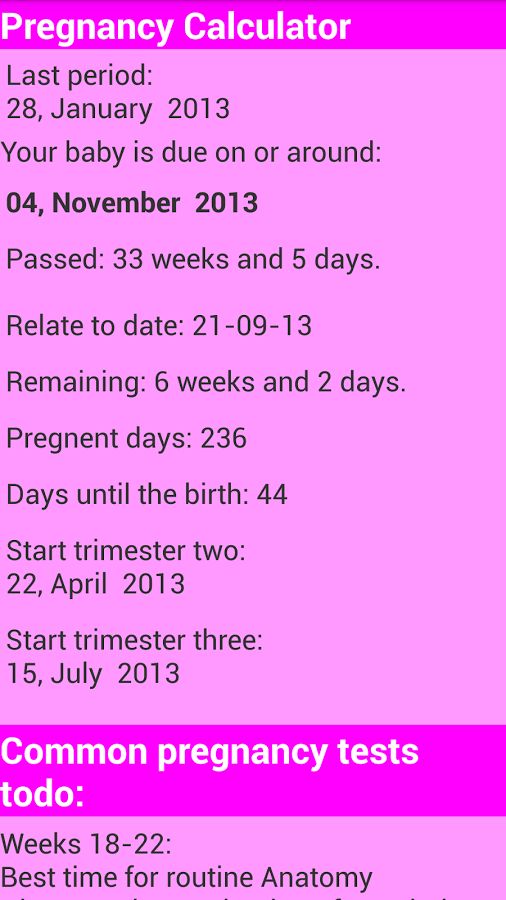
According to the size of the uterus
Examining a woman in a gynecological chair, an obstetrician-gynecologist determines the size of the uterus with both hands. In this case, you can also determine the approximate gestational age.
This method will be most accurate in early pregnancy, up to about 12 weeks. The earliest period that can be determined by the size of the uterus is 5 weeks of pregnancy. By this time, the uterus is slightly enlarged, softened and becomes rounded. At later dates, the size of the uterus may vary slightly depending on the size of the fetus, the amount of amniotic fluid, and the structure of the woman's pelvis. For example, it is believed that at 16 weeks the bottom of the uterus is located in the middle of the distance between the pubis and the navel, at 24 weeks of pregnancy the bottom of the uterus is at the level of the navel.
Ultrasound
In the early stages of pregnancy, by measuring the size of the ovum and embryo, the gestational age can be determined with great accuracy.
At 4-5 weeks, a small “black circle” is detected in the uterus during ultrasound examination - this is a fetal egg, in which an embryo will appear a little later. At about 6-7 weeks, the embryo appears in the form of a small “stripe” and you can see its heartbeat. More accurate is the period calculated by measuring the KTP of the embryo (KTP is the coccygeal-parietal size, that is, the maximum distance from the head end of the fetus to its tailbone), and not by the diameter of the fetal egg.
After 12 weeks, the gestational age during ultrasound is determined according to the so-called fetometry, that is, measurements of various sizes of the head and abdomen of the fetus, length of arms, legs, heart sizes, etc. are used to calculate the term.
Up to 9-10 weeks of pregnancy, the embryo grows proportionally, and its size in all women with the same gestational age will be approximately identical. In the future, the size of the fetus will differ in expectant mothers of different nationalities, with different body weights, the weight of the mother and father at birth will matter, and so on.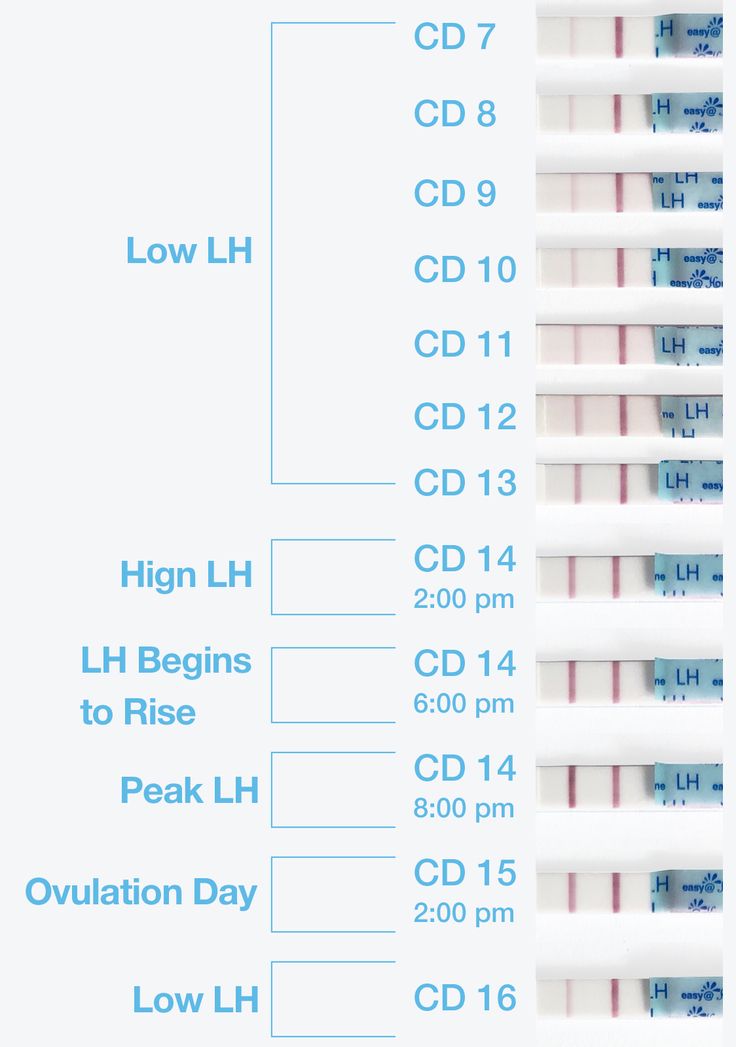 That is, in the later stages of pregnancy, normally developing children of the same term may have different sizes (fluctuations can be about 2 weeks, sometimes more), and in such a situation, it is impossible to reliably determine the gestational age according to ultrasound data. In the later stages, the determination of the gestational age by ultrasound is only clarifying. In addition, the lag in the size of the fetus during ultrasound at long gestations is most often regarded by doctors as a developmental disorder due to the fact that the placenta does not transport oxygen and nutrients well enough.
That is, in the later stages of pregnancy, normally developing children of the same term may have different sizes (fluctuations can be about 2 weeks, sometimes more), and in such a situation, it is impossible to reliably determine the gestational age according to ultrasound data. In the later stages, the determination of the gestational age by ultrasound is only clarifying. In addition, the lag in the size of the fetus during ultrasound at long gestations is most often regarded by doctors as a developmental disorder due to the fact that the placenta does not transport oxygen and nutrients well enough.
At the Fetal Medicine Center in Moscow, all types of ultrasound during pregnancy are performed at an expert level, including ultrasound in early pregnancy.
Our center is organized in such a way that the whole range of services is concentrated in one place, where a woman receives the results of various types of examinations, including ultrasound, biochemical, and specialist consultation within 1-1. 5 hours.
5 hours.
Blood hCG level
HCG (human chorionic gonadotropin) is a hormone released during pregnancy by the placenta. It begins to be produced with the onset of pregnancy, gradually its amount increases, until about the 11th week of pregnancy, and then begins to decrease slightly.
Determining the concentration of hCG in the blood in the early stages of pregnancy helps to accurately determine the period. Having received the results of a blood test for hCG, it is worth paying attention that in the laboratory tables of the correspondence of the hormone level to the gestational age, the embryonic period is often indicated, that is, to determine the usual obstetric gestational age, 2 weeks should be added to the result.
Recently, tests have appeared to determine the duration of pregnancy by urine. They also determine the concentration of the hCG hormone in the urine of a pregnant woman and, in addition to confirming the very fact of pregnancy, show what period the hormone content corresponds to. The only thing to remember is that urine tests also show the fetal gestational age.
The only thing to remember is that urine tests also show the fetal gestational age.
The Fetal Medicine Center performs all types of tests for pregnant women.
Determining the term of pregnancy by the first movement of the fetus
This method of determining the term has recently been used less and less. It is based on the fact that nulliparous women begin to feel the first movements of the baby at 20 weeks of gestation, multiparous women a little earlier - at 18 weeks. That is why obstetrician-gynecologists recommend that a woman remember the date of the first movement of the fetus and enter this data into the exchange card.
However, this method of determining gestational age is often erroneous.
A mother who is expecting her first child, indeed, most often begins to feel the movements of the fetus a little later than a multiparous woman. This is due to the fact that "experienced" mothers know how the movements of the crumbs are felt at first and what they should feel. Some primigravidas perceive the first movements of the fetus as an increase in intestinal peristalsis, “gaziki”.
Some primigravidas perceive the first movements of the fetus as an increase in intestinal peristalsis, “gaziki”.
Many women describe the first fetal movements as a feeling of liquid transfusion in the abdomen, "fluttering butterflies" or "swimming fish". The first movements are usually rare, irregular. The time of the first sensations of fetal movements naturally depends on the individual sensitivity of the woman. Some future mothers feel the first movements as early as 15-16 weeks, and someone only after 20. Slender women, as a rule, begin to feel movements earlier than full ones. Women who lead an active lifestyle, work hard, usually feel the movements of the fetus later.
After determining the gestational age, the doctor can calculate the approximate date of delivery. On average, the duration of pregnancy is 280 days or 40 weeks (do not forget that obstetric term is meant).
Irregular menstrual cycle - is there a chance of getting pregnant? But if the cycle is irregular, then calculating the date of ovulation will not give accurate results.
 This means that you will have to resort to less convenient methods: ultrasound, tests, measuring basal temperature.
This means that you will have to resort to less convenient methods: ultrasound, tests, measuring basal temperature. Causes of irregular cycles
Irregular periods are the result of hormonal imbalance. The following reasons can lead to it:
- Physiological factors: stress, poor nutrition, regular flights with changing climatic zones, sudden weight gain or, conversely, weight loss.
- Diseases: endometriosis, uterine fibroids, polycystic ovary syndrome, chronic diseases of the pelvic organs, thyroid gland. Even SARS with a temperature of 37 ° C often causes a violation of the cycle.
- Taking certain medications: hormonal drugs (not necessarily female hormones), anticoagulants, anticonvulsants disrupt the balance of hormones in the body.
How to increase the chance of pregnancy with an irregular cycle?
The first thing to do when planning a pregnancy with an irregular cycle is to visit a gynecologist.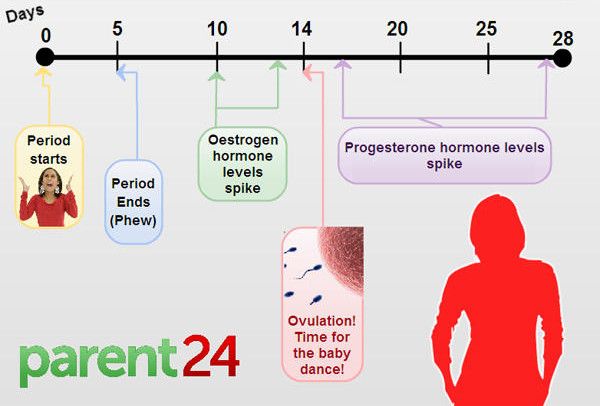 The doctor will examine you, prescribe examinations, the results of which will identify the problem and determine ways to solve it.
The doctor will examine you, prescribe examinations, the results of which will identify the problem and determine ways to solve it.
In some cases, hormones are prescribed, but it is often possible to restore the cycle without hormonal drugs. But at the same time, an integrated approach is important.
Taking non-hormonal drugs
Specialized non-hormonal complexes are aimed at eliminating a specific cause of failure in the menstrual cycle.
One of the most common causes of irregular periods is elevated prolactin levels. Complex 9 will help to cope with this problem with moderate hyperprolactinemia0108 Pregnoton . It contains Vitex extract, which helps to restore hormonal balance due to a mild effect on the pituitary gland - it is he who regulates the production of prolactin. In addition, the L-arginine contained in Pregnoton improves the supply of oxygen to the pelvic organs and normalizes the thickness of the endometrium.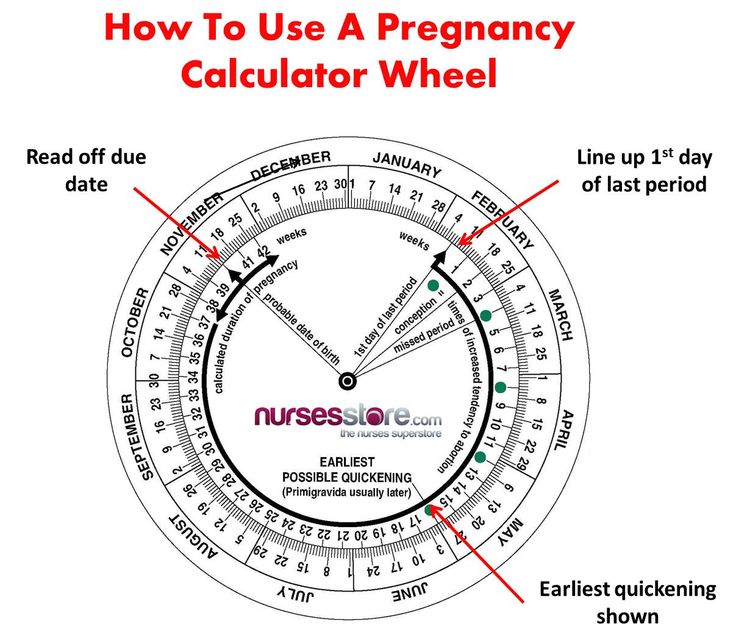 Pregnoton also includes vitamins and minerals that are needed for the normal functioning of the female reproductive system: folic acid, vitamin E, iodine and others.
Pregnoton also includes vitamins and minerals that are needed for the normal functioning of the female reproductive system: folic acid, vitamin E, iodine and others.
Another common cause of irregular menses is polycystic ovaries. In this case, to restore ovulation, inositol is prescribed, due to the deficiency of which the mature follicle does not break. If a woman is also diagnosed with metabolic syndrome along with PCOS, inositol intake should be supplemented with alpha-lipoic acid, manganese and vitamin D3, which help to normalize metabolism and reduce the level of male sex hormones. All these substances are contained in the preparation Diferton - it is designed specifically to restore the cycle and non-hormonal support of the reproductive system in PCOS and metabolic syndrome.
The transition to a balanced diet
Both strict diets and overeating can lead to cycle disorders. In the first case, menstruation stops due to a lack of fats (they are needed for the synthesis of female hormones), in the second - due to their excess (leading to an increase in the level of male hormones). Therefore, it is important to adhere to the principles of a healthy diet with the right ratio of proteins, fats and carbohydrates, without starvation.
Therefore, it is important to adhere to the principles of a healthy diet with the right ratio of proteins, fats and carbohydrates, without starvation.
Physical activity
Moderate physical activity is useful for cycle recovery - swimming, hiking, cycling, fitness, running, Pilates and yoga, tennis. Regular exercise activates blood circulation in the pelvis, prevents blood buildup.
Reducing stress and anxiety
Stress increases the production of cortisol and prolactin hormones in the body, which causes hormonal imbalance.
Hobbies, positive emotions, rest help to fight stress and increased anxiety. If reading the news or watching any programs makes you insecure about the future, give them up if you want to conceive a child.
Normalization of the menstrual cycle does not happen quickly - it will take at least 3 months. If you are planning a pregnancy, then at this time it is worth using ovulation tests to determine the optimal days for conception.



